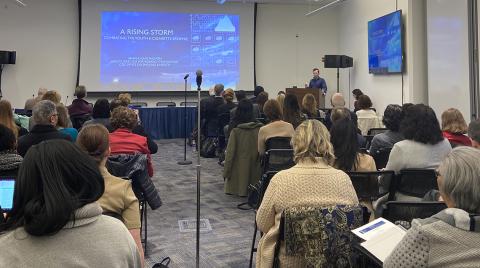Workshop Addresses Youth Vaping Epidemic

Photo: Jen Hession
There’s a vaping epidemic among our youth, and we need to prioritize research that identifies and deploys the most effective prevention strategies, while helping those already addicted to stop using. These are the conclusions of a multidisciplinary workshop held Mar. 2-3 and organized by NHLBI, ODP, NCI, NIDA, OBSSR and others.
Long before the recent e-cigarette, or vaping, product use-associated lung injury outbreak that mobilized public health officials, young people were getting hooked. Dr. Brian King of the CDC’s Office on Smoking and Health noted in the workshop’s opening session that e-cigarette use among youth in the last 10 years has skyrocketed among both middle and high schoolers.
This rate hike has been driven by multiple factors such as targeted advertising, the use of enticing flavors and the development of extremely addictive products. And because new products are emerging all the time, “We must modernize and adapt our approach to researching the issue and establishing policies to stay current,” he said.
Reducing e-cigarette use among youth may seem daunting, but we can potentially apply lessons learned from earlier tobacco control research and policy decisions, attendees learned.
For instance, peer leader models have been used successfully in teen cigarette smoking prevention. And research on vaping shows that kids with fewer peer bonds and fewer positive adult connections are more likely to vape.
“Researchers need to leverage peer influence in prevention and promote accurate perceptions of risk. We should also consider the influence of older adolescents” on younger kids, said Dr. Peter Wyman of the University of Rochester.
Data has already shown that the basic “vaccine” against smoking—a combination of smoke-free policies, price increases, access to cessation methods or treatments and media campaigns—can successfully curb tobacco use. In fact, youth use of tobacco products decreased significantly between 1990 and 2018 due in no small part to policy shifts and restrictions. But as Dr. Tesfa Alexander of FDA’s Center for Tobacco Products noted, the e-cigarette industry’s volatility and constantly shifting product landscape may call for a different approach.
Existing tobacco cessation campaigns that have been tweaked to address e-cigarettes show promise. For example, FDA’s Real Cost Campaign, first conceived to divert teens from cigarette smoking, has widened its scope to include e-cigarettes. Initial testing of vaping prevention ads suggest they resonate with youth just as well as anti-cigarette ads, but it remains to be seen if they can influence behavior and prompt users to quit.
Dr. Donna Vallone of the Truth Initiative called for the research community “to improve our understanding of the digital landscape where youth spend so much of their time,” so we can effectively leverage it. Recognizing that the vaping industry had already “lit the tech trend” by placing its ads and influencer endorsements on the social media apps most used by youth, the Truth Initiative aims to counteract the industry’s messaging with its “This Is Quitting” or TIQ campaign. TIQ includes a texting support program—with 130,000 young people signing up in just 1 year—and the #thisisquitting campaign on TikTok, a wildly popular app among the 16- to 24-year-old demographic.
In 2019, some states began to implement policy changes designed to restrict e-cigarette use, and federal efforts also are underway, but many gaps remain. In addition, workshop participants cited concerns about unintended consequences of e-cigarette policy restrictions. For instance, if and when more restrictive policies are enacted, how well will they align with existing cessation resources? Will restrictions on e-cigarettes inadvertently tilt teens back toward using combustible tobacco products?
As the workshop participants brainstormed a list of clinical and policy-oriented research topics, there was general agreement that we need to develop and test tailored interventions, implementation strategies and prevention efforts, as well as link channels of influence to ensure cross-disciplinary engagement.
